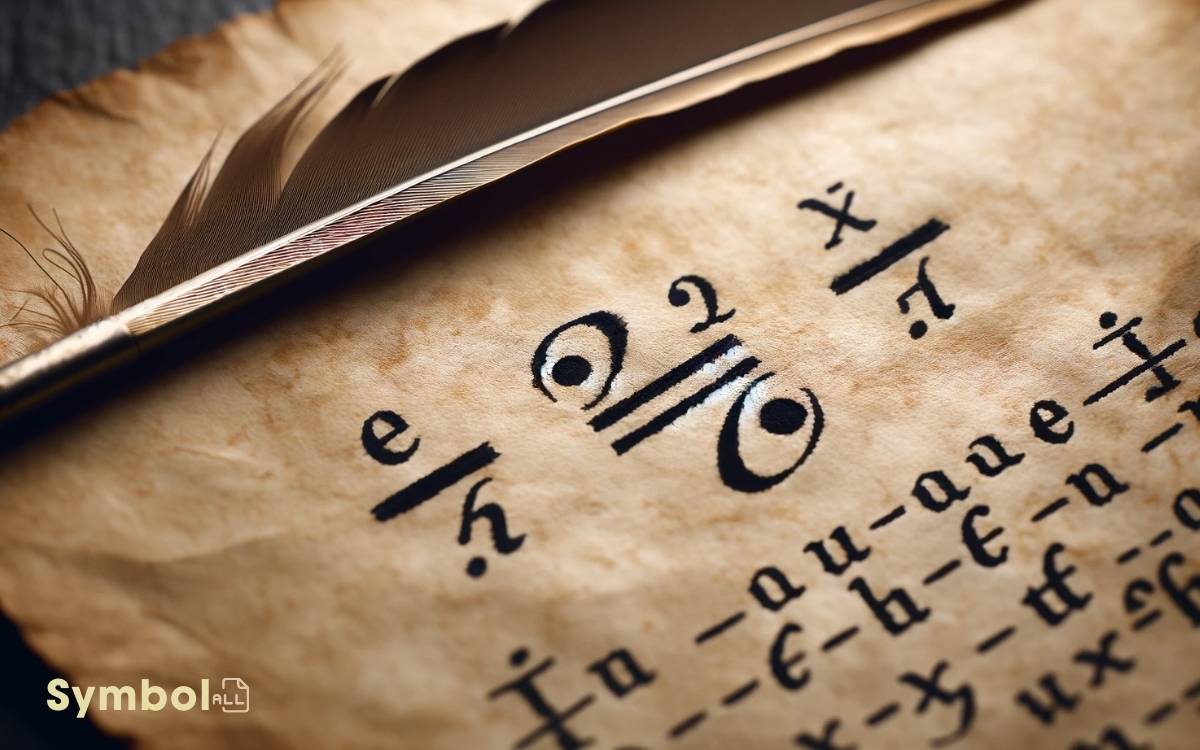A Mathematical Sentence With an Equal Symbol Used: Equation!
A mathematical sentence with an equal symbol represents a declaration of equality between two expressions. This equal symbol signals that the values on either side are the same, laying the groundwork for problem-solving and theoretical proof.
Essentially, you’re looking at a foundational concept in mathematical reasoning, a vehicle for translating real-life issues into solvable problems.
Whether it’s a simple equation like 2+3=5 or a more complex algebraic expression, the presence of the equal sign serves as both a connector and a validator of balance and equivalence.
Engaging further can illuminate this fundamental principle’s role in advancing your understanding across various mathematical concepts.

Key Takeaways
Understanding Equal Symbols
At its core, the equal symbol (=) signifies that the values on either side are precisely the same. This fundamental concept lies at the heart of mathematical reasoning and communication.
When you see this symbol, you’re looking at a statement of equality. It’s a declaration that, despite any differences in appearance or form, the quantities or expressions you’re comparing hold the same value.
It’s imperative you understand this, as it forms the basis for solving problems and proving theories. The equal symbol isn’t just a marker; it’s a bridge connecting two ideas, showing they’re equivalent in value.
Grasping this concept allows you to approach mathematical problems with a clearer perspective, ensuring you’re not just following steps but truly understanding the principles at play.
The Basics of Equations
Building on the concept of equality, let’s explore the basics of equations. You’ll learn how these mathematical sentences express relationships between equal values.
At their core, equations are tools that convey importance. They’re composed of two expressions, one on each side of an equal sign, indicating that what’s on the left has the same value as what’s on the right.
You’ll encounter equations in various mathematical disciplines, from algebra to calculus, each serving a unique purpose. Their beauty lies in their ability to represent complex relationships in a straightforward manner.
Understanding equations is essential because they form the foundation for solving problems and discovering new mathematical truths.
They’re not just symbols on a page; they’re the language of mathematics, allowing you to translate real-world problems into solvable mathematical puzzles.
Anatomy of a Mathematical Sentence
Every mathematical sentence, at its essence, conveys a precise relationship between numbers or variables, embodying the foundational structure upon which mathematical reasoning is built.
You’ll encounter terms like expressions, coefficients, and constants, which are the building blocks of these sentences. Understanding their roles and how they interact within an equation is essential for solving mathematical problems efficiently.
| Component | Description | Example |
|---|---|---|
| Expression | A combination of numbers and variables | \(2x + 3\) |
| Coefficient | A number used to multiply a variable | In \(2x\), 2 |
| Constant | A value that doesn’t change | In \(2x + 3\), 3 |
| Variable | A symbol that represents an unknown number | \(x\) |
| Equal Symbol | Indicates that two expressions are equivalent | \(=\) |
Types of Mathematical Equations
You’re now entering the world of mathematical equations, where symbols and numbers tell stories of relationships and solutions.
We’ll start by breaking down linear equations, then move on to the complexities of quadratic equations, and finally, cover the essentials of polynomial equations.
Each type offers a unique perspective on how variables interact and lead to various solutions.
Linear Equations Overview
When delving into types of mathematical equations, it’s crucial to comprehend that linear equations, which are characterized by variables raised to the power of one, form the basis for much of algebra.
Here’s a breakdown to assist you in understanding their importance:
- Importance: Linear equations involve basic operations like addition, subtraction, and multiplication by constants.
- One Solution: Generally, they’ve a single solution, making them easy to solve.
- Graph Representation: When plotted, they result in a straight line, hence the term ‘linear’.
- Real-world Applications: They’re utilized to address problems in fields like economics, physics, and engineering, where relationships between two variables are straightforward and proportional.
Grasping linear equations establishes the groundwork for approaching more intricate mathematical concepts, offering a sturdy algebraic base.
Quadratic Equations Explained
Having established a foundation in linear equations, we’ll now explore quadratic equations, which introduce variables raised to the power of two. These equations take the form ax^2 + bx + c = 0, where ‘a’, ‘b’, and ‘c’ are constants, and ‘x’ represents the variable.
Unlike linear equations, quadratics can have two solutions, due to the squared variable. This characteristic shapes their graph into a parabola, opening upwards or downwards depending on the sign of ‘a’.
Solving them often involves factoring, completing the square, or applying the quadratic formula, \( rac{-b \pm \sqrt{b^2-4ac}}{2a}\). Each method offers insights into the equation’s roots and how they relate to the parabola’s vertex and axis of symmetry.
Understanding quadratics deepens your grasp of algebra, preparing you for more complex mathematical concepts.
Polynomial Equations Basics
Let’s explore the fundamentals of polynomial equations, an essential category within the domain of mathematical sentences.
These equations are characterized by variables raised to whole number exponents and can range from simple to complex. Understanding them is key to mastering various aspects of mathematics.
Here’s a brief overview:
- Definition: A polynomial equation involves a sum of terms, each consisting of a coefficient multiplied by a variable raised to a non-negative integer exponent.
- Degree: The highest exponent of the variable determines the equation’s degree, influencing its complexity and the number of solutions.
- Types: These include linear, quadratic, cubic, and quartic polynomials, each with a different degree and characteristics.
- Solutions: Solving polynomial equations can involve factoring, graphing, or using algebraic formulas, depending on the equation’s degree and form.
Understanding these basics equips you to explore further into the subject.
The Importance of Balance
Understanding the concept of balance is essential in interpreting mathematical sentences featuring the equal symbol. The equal symbol signifies that what’s on its left side has the same value as what’s on its right side, much like a balanced scale.
In mathematics, maintaining this balance is vital. When you manipulate an equation, you’re fundamentally adjusting the weights on both sides of the scale. You must do so with precision and care to guarantee the balance remains intact.
This concept isn’t just a mathematical rule; it’s a fundamental principle that underlies the integrity of equations. Without balance, the equation loses its meaning, leading to incorrect conclusions.
Hence, grasping the importance of balance prepares you for more complex problem-solving, making sure you approach equations with the necessary respect for their structure.
Solving Simple Equations
Now that you grasp the importance of balance in equations, it’s time to apply this understanding to solving simple equations.
Solving them involves a few clear steps:
- Isolate the variable on one side of the equation. This means you’ll have to move everything else to the opposite side.
- Perform the same operation on both sides of the equation to maintain balance. If you add a number to one side, you must add the same number to the other side.
- Simplify the equation as much as possible. This might involve combining like terms or simplifying fractions.
- Solve for the variable by completing any necessary arithmetic operations.
These steps will help you find the solution to the equation, ensuring you’re applying a structured approach to uncover the value of the unknown.
Variables and Constants Explained
In the domain of mathematics, distinguishing between variables and constants is essential for solving equations effectively.
Variables are symbols that represent unknown values and can change. You’ll often see them as letters like x, y, or z in equations. They’re the pieces of the puzzle you’re trying to solve.
On the other hand, constants are the fixed values in equations. These are the numbers that don’t change, such as 3, -5, or 100.
Understanding the role of each is vital. Variables give equations flexibility, allowing them to represent a range of situations. Constants anchor the equations, providing a stable reference point.
Grasping these concepts lets you manipulate and solve equations with confidence, paving the way for more complex mathematical exploration.
Algebraic Expressions Unveiled
Now that you’re familiar with variables and constants, let’s explore algebraic expressions, where these elements combine to form meaningful mathematical phrases.
You’ll learn how variables play an important role in expressions and the strategies for simplifying complex expressions.
This knowledge is essential for mastering the language of algebra and solving equations effectively.
Understanding Algebraic Expressions
Let’s explore the world of algebraic expressions, where you’ll learn how to interpret and manipulate these mathematical phrases that represent numbers and operations.
Understanding these expressions is essential as they form the basis of algebra, allowing you to solve problems and understand mathematical relationships.
Here’s a quick guide:
- Constants – Fixed values that don’t change.
- Coefficients – Numbers that multiply the variables (avoid discussing variables in detail).
- Operators – Symbols that show operations (addition, subtraction, etc.).
- Terms – Each part of the expression separated by plus or minus signs.
Variables in Expressions
Diving deeper into algebraic expressions, you’ll encounter variables, the essential elements that represent unknown values. These placeholders, often denoted by letters such as x, y, or z, are the cornerstone of algebraic thinking.
They allow you to generalize mathematical relationships and operations, opening the door to solving a vast array of problems.
When you see a variable in an expression, it’s your cue that the value isn’t fixed; it can vary depending on the situation or the problem at hand.
Understanding how to work with variables is vital. They’re not just symbols; they’re tools that enable you to explore and express mathematical ideas in a dynamic way. Grasping their role and function is a significant step toward mastering algebra.
Simplifying Complex Expressions
Building on your understanding of variables in expressions, we’ll explore how to simplify complex algebraic expressions, a key skill in mastering algebra.
Simplifying complex expressions can seem challenging at first, but it’s about understanding and applying a few basic principles.
Here’s a structured approach:
- Combine like terms: Group and add or subtract variables of the same degree.
- Use the distributive property: Apply this property to remove parentheses by multiplying each term inside the parentheses by the term outside.
- Factor when possible: Look for common factors in terms and simplify them.
- Simplify fractions: Reduce fractions within the expression to their simplest form.
Strategies for Complex Equations
When tackling complex equations, your understanding of strategic approaches can greatly streamline the solving process. First, identify the type of equation you’re dealing with, as strategies differ between linear, quadratic, and higher-order polynomials.
Breaking the problem into smaller, manageable parts can reveal a clear path to the solution. For instance, isolating variables on one side simplifies the equation, making it easier to solve.
Utilizing substitution methods where you solve for one variable and then substitute that solution into other equations can efficiently reduce complexity. Always check your solutions by plugging them back into the original equations to verify their correctness.
Real-Life Applications
Understanding strategies for complex equations equips you with the tools to tackle real-life problems where mathematics plays a pivotal role.
Equations aren’t just academic exercises; they’re crucial in various scenarios, including:
- Budgeting and Finance: Calculating interest, savings, and loan repayments requires understanding and applying equations to manage your finances effectively.
- Cooking and Baking: Adjusting recipes based on servings involves ratios and proportions, which are forms of equations.
- Construction and Engineering: Determining the amount of materials needed for a project, or the stress on structural elements, relies on equations to guarantee safety and efficiency.
- Healthcare: Dosage calculations for medications are determined through equations to provide the correct amount based on weight or age.
In each of these instances, equations serve as tools for solving practical problems, demonstrating their importance beyond the classroom.
Common Mistakes to Avoid
Many students often overlook simple errors in their haste to solve equations, leading to incorrect solutions. It’s essential to pay attention to detail and avoid common pitfalls that can derail your work.
Here’s a table to help you remember what to watch out for:
| Mistake Type | Example |
|---|---|
| Misplacing signs | 5 + (-2) ≠ 5 – 2 |
| Ignoring order of operations | 3 + 2 * 5 ≠ 25 |
| Incorrectly simplifying expressions | (a + b)^2 ≠ a^2 + b^2 |
The Role of Inequalities
You’ve learned about equations; now, it’s time to explore inequalities, which express the concept of less than or greater than rather than importance. Understanding inequalities is essential, not just for solving math problems but for applying these concepts to real-life situations.
We’ll start by defining mathematical inequalities, see how they fit into everyday scenarios, and then tackle solving inequality problems.
Defining Mathematical Inequalities
In the domain of mathematics, inequalities play an essential role by comparing the relative size or order of two values or expressions.
To grasp their significance, consider the following points:
- Symbols: The most common symbols are `<` (less than), `>` (greater than), `≤` (less than or equal to), and `≥` (greater than or equal to).
- Expressions: They can compare simple numbers, like 2 < 3, or complex expressions, such as \(x^2 – 4 < 0\).
- Solution Sets: Inequalities often have multiple solutions, forming a range or set of values that satisfy the condition.
- Graphical Representation: They can be graphically represented on a number line, showcasing the solution set visually.
Understanding inequalities allows you to analyze and solve problems concerning limits, ranges, and conditions within mathematics.
Inequalities in Real Life
Understanding inequalities is essential, as they often shape decisions in your daily life, from budgeting to making choices based on weather forecasts. These mathematical concepts aren’t just abstract theories; they’re tools that help you navigate through various scenarios efficiently.
| Scenario | Inequality Example | Real-Life Application |
|---|---|---|
| Budgeting | Income > Expenses | Ensuring savings |
| Weather Forecast | Temperature < 0°C | Deciding to wear warmer clothes |
| Cooking | Cooking Time ≥ 30 minutes | Planning meal preparation time |
| Fitness Goals | Calories Burned > Intake | Achieving weight loss |
| Academic Grading | Score ≥ 90 | Qualifying for honors distinction |
These examples illustrate how inequalities guide everyday decisions, emphasizing the importance of understanding and applying them correctly.
Solving Inequality Problems
To tackle inequality problems effectively, it’s vital to grasp how these mathematical expressions mirror real-world scenarios, guiding your decision-making process.
Here’s how you can approach them:
- Identify the inequality: Recognize whether it’s a less than, greater than, less than or equal to, or greater than or equal to scenario.
- Isolate the variable: Use algebraic manipulations to get the variable on one side of the inequality.
- Solve the inequality: Apply arithmetic operations carefully, remembering to flip the inequality sign when multiplying or dividing by a negative number.
- Check your solution: Plug back your solution into the original inequality to make sure it makes sense.
Understanding and solving inequalities allow you to navigate through decisions where precision and range are pivotal.
Beyond the Equal Sign
Exploring beyond the equal sign reveals a world where mathematical relationships take on more intricate and varied forms. You’ll encounter inequalities, which express relationships not of strict equality but of greater than or lesser than.
These aren’t just about numbers; they’re about understanding how quantities relate in a broader sense.
You’ll also investigate functions, where you learn how every input relates to a specific output, a concept that’s foundational in both simple and advanced mathematics.
Additionally, understanding these concepts allows you to grasp the beauty and utility of mathematics in describing the world.
Whether you’re evaluating financial decisions, predicting outcomes, or solving real-world problems, the knowledge you gain here is invaluable. It’s about seeing past the simple balance of equations and appreciating the dynamic relationships they represent.
Advanced Problem-Solving Techniques
As you explore advanced problem-solving techniques, you’ll uncover methods that turn intricate challenges into manageable tasks.
These strategies provide a structured approach to dissecting and solving complex problems:
- Break Down the Problem: Divide the problem into smaller, more manageable pieces.
- Identify Patterns: Look for recurring themes or patterns that can simplify the problem.
- Apply Theoretical Concepts: Use mathematical theories and principles to form a foundation for your solution.
- Iterative Refinement: Refine your solution incrementally, testing and adjusting as necessary.
Encouraging Mathematical Curiosity
Fostering a sense of mathematical curiosity can greatly enhance your ability to tackle complex problems with enthusiasm and creativity. It’s about asking questions, not just about the how, but the why behind mathematical principles.
Start by engaging with puzzles and problems that challenge your current understanding. Don’t shy away from concepts that seem intimidating at first glance. Dive deeper into the logic and structure behind mathematical sentences, especially those involving the equal symbol.
This isn’t just about finding the right answer; it’s about understanding the journey to that answer. By breaking down equations and exploring different methods of solving them, you’ll uncover a richer, more nuanced understanding of mathematics.
This approach encourages a proactive, inquisitive mindset, essential for mastering advanced problem-solving techniques and pushing the boundaries of your mathematical knowledge.
Conclusion
In your journey through the mathematical landscape, the equal sign is your compass, guiding you towards balance and harmony in the domain of numbers. It’s not just about solving equations; it’s about understanding the language of the universe.
As you explore deeper, embracing both sides of the equal sign, you’ll uncover the beauty in balance, the power of precision, and the thrill of discovery.
Let your curiosity lead the way, and always remember, in every equation lies a story waiting to be unraveled.






